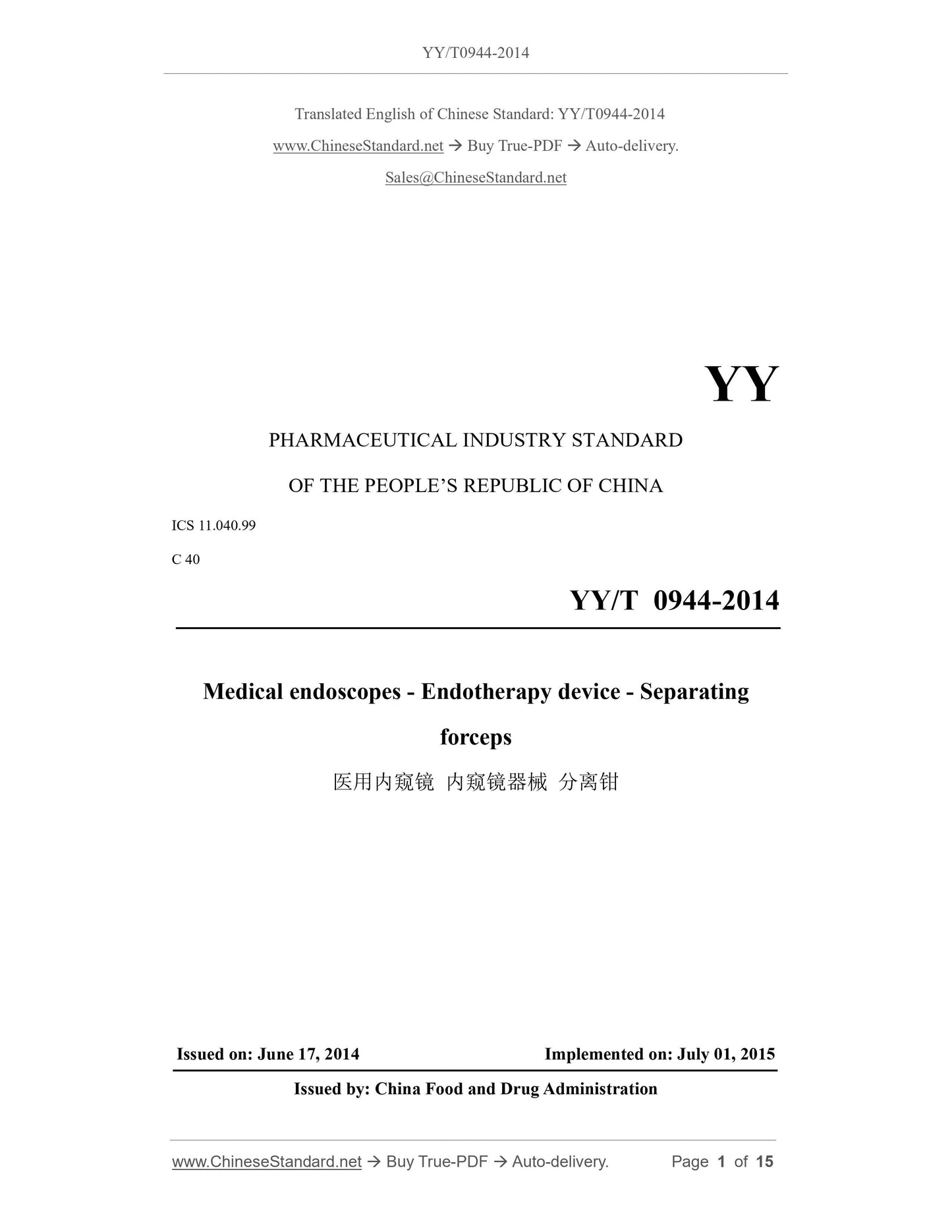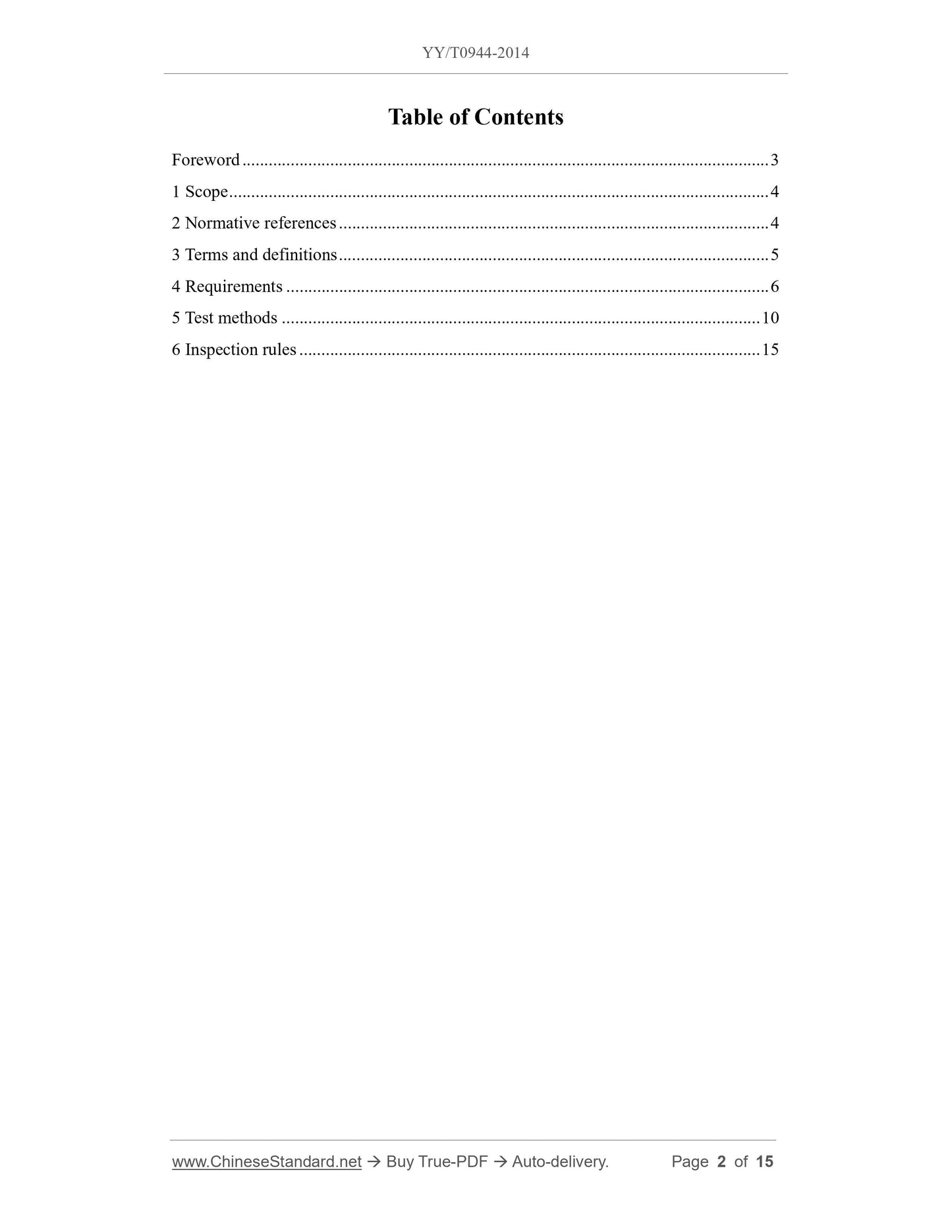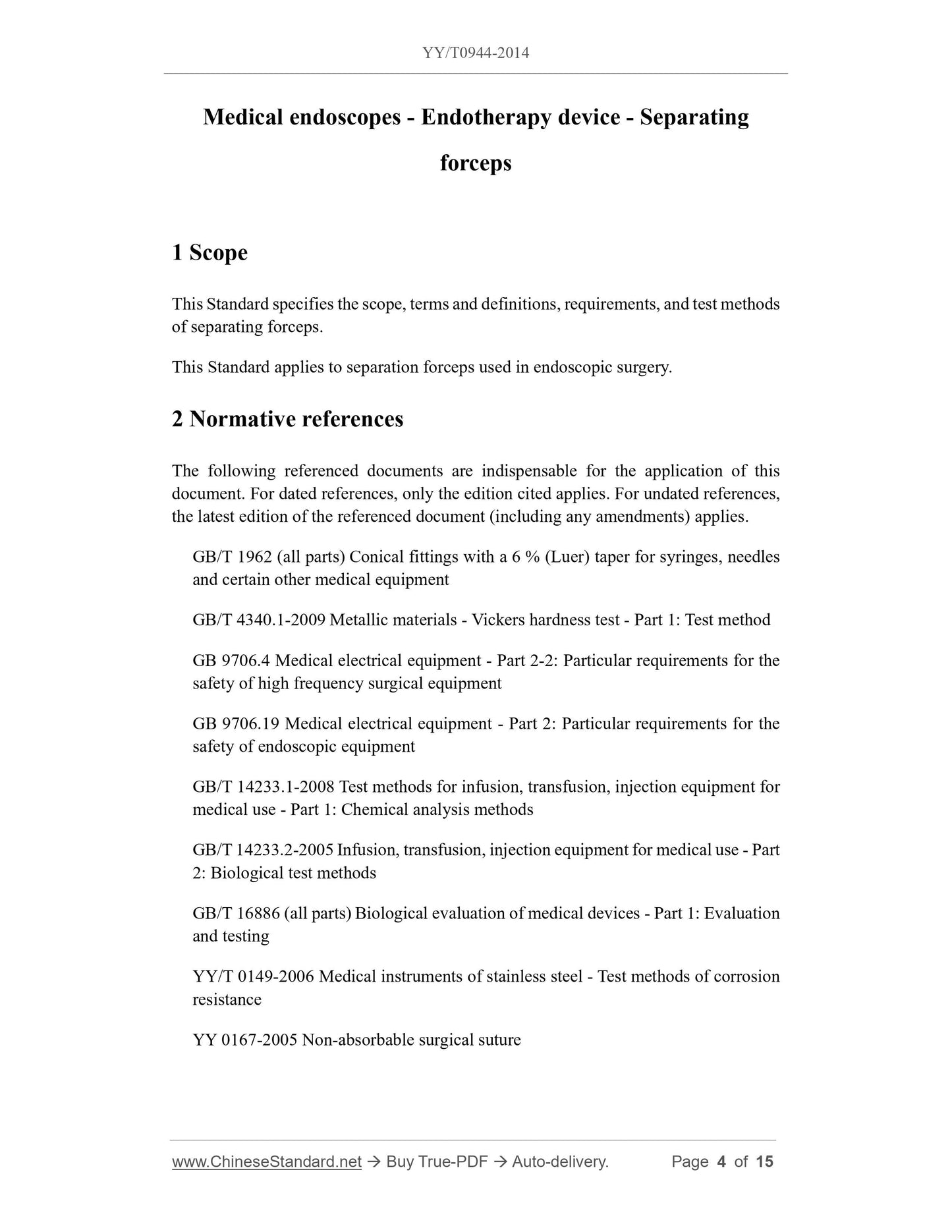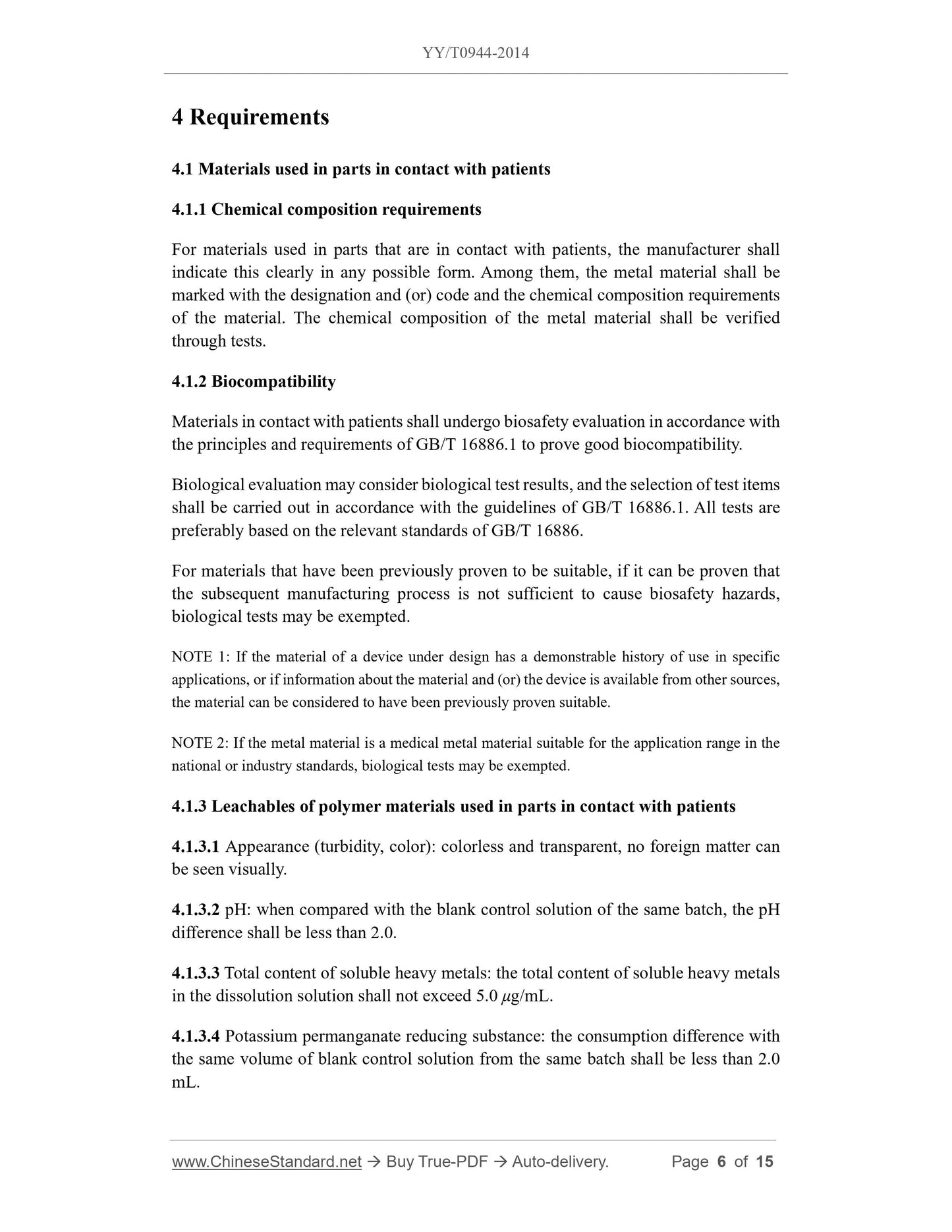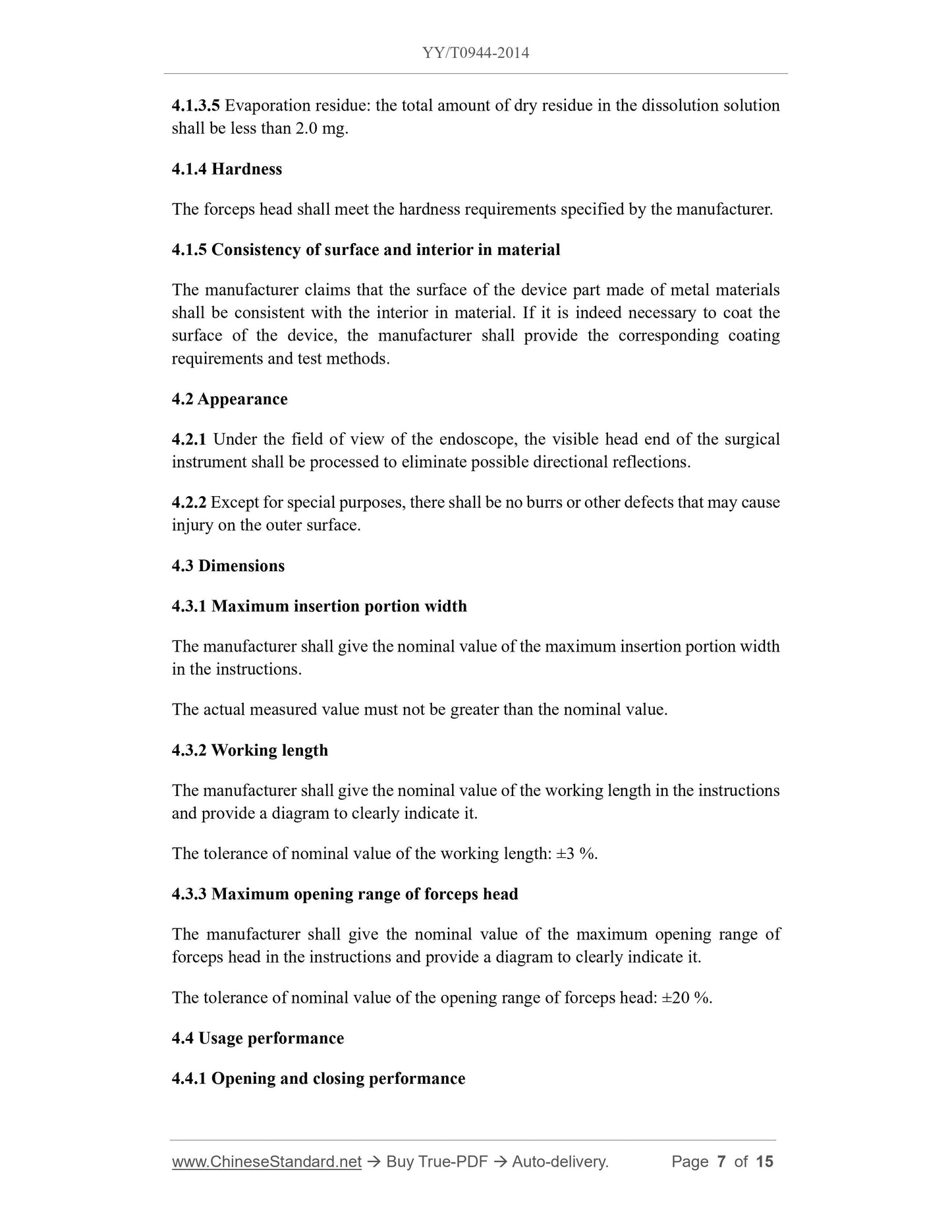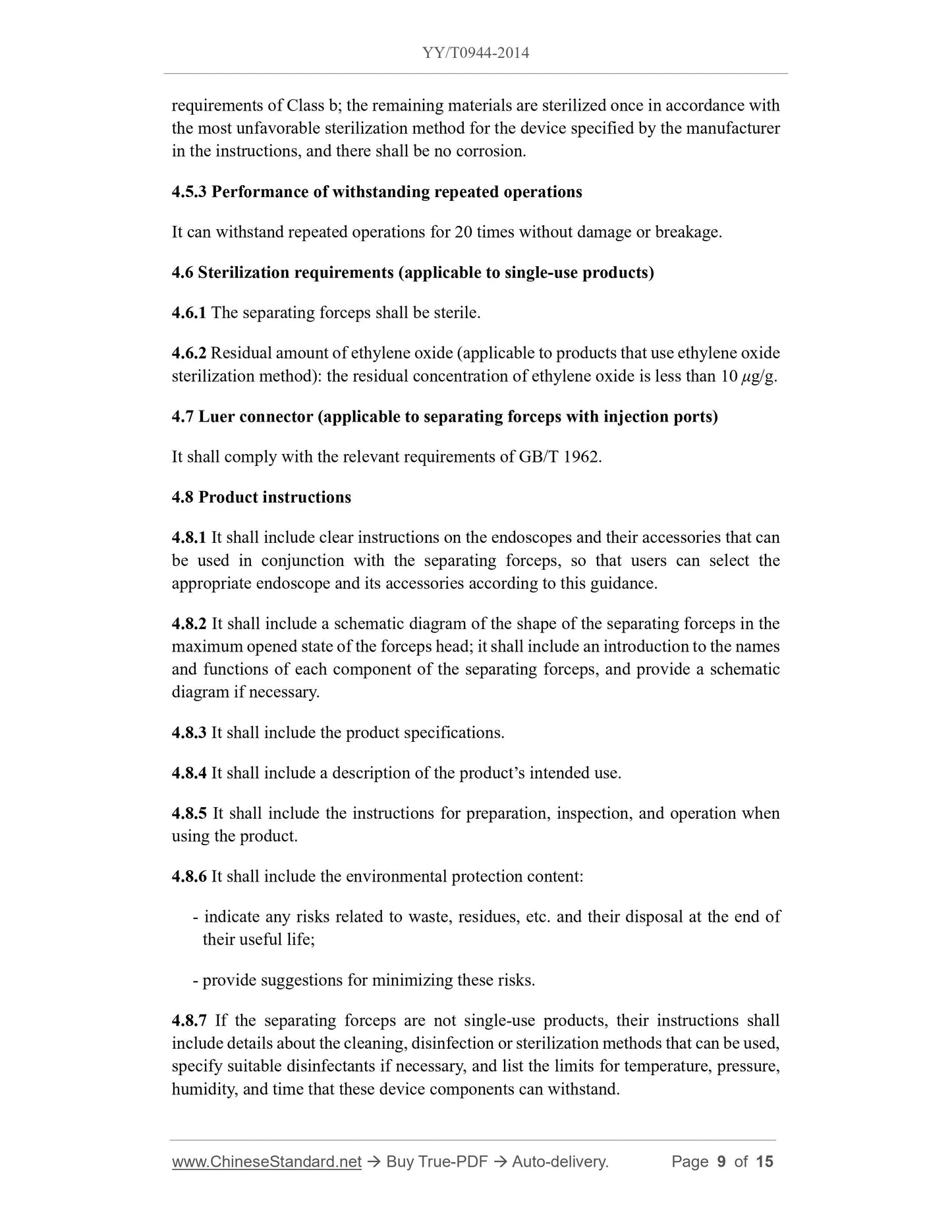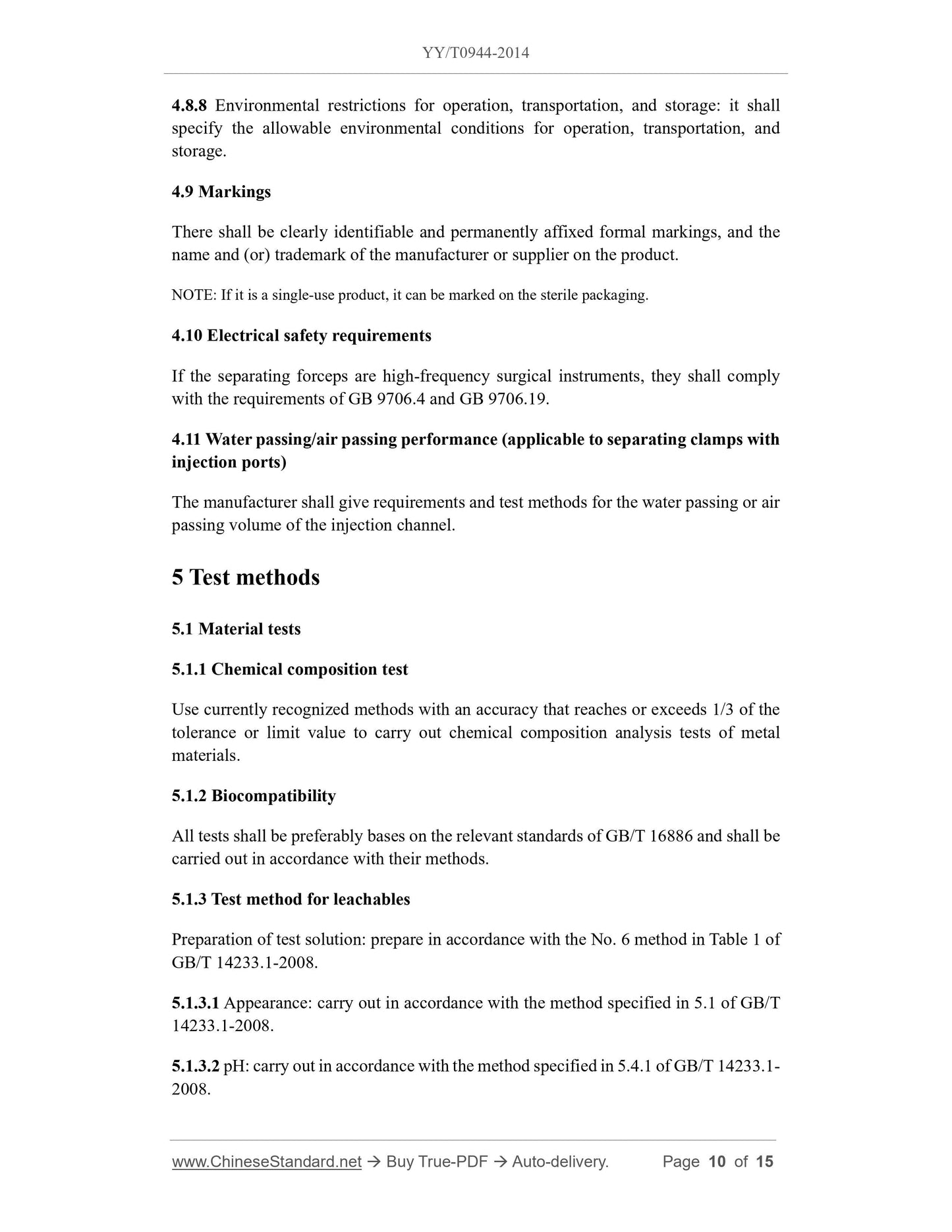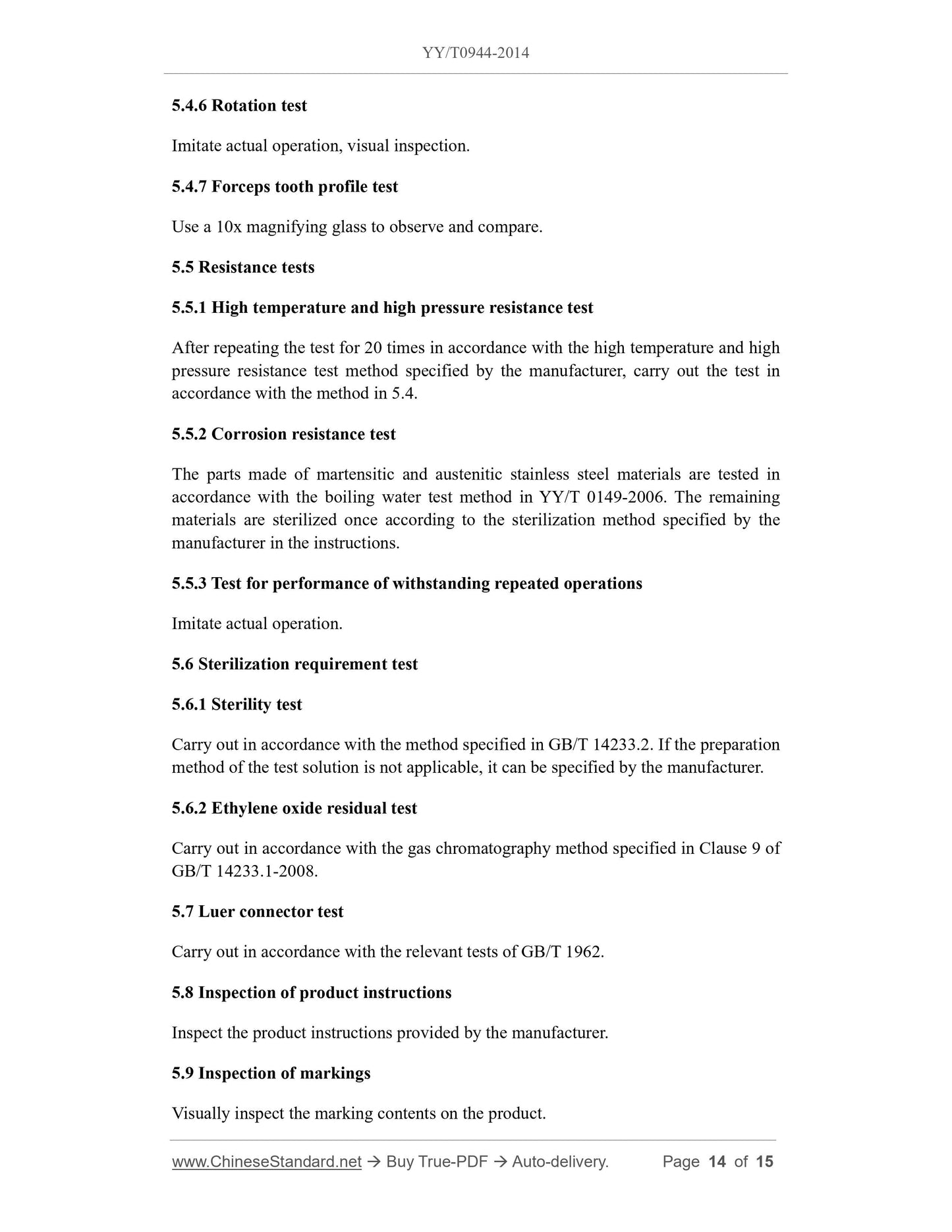1
/
von
8
PayPal, credit cards. Download editable-PDF and invoice in 1 second!
YY/T 0944-2014 English PDF (YYT0944-2014)
YY/T 0944-2014 English PDF (YYT0944-2014)
Normaler Preis
$165.00 USD
Normaler Preis
Verkaufspreis
$165.00 USD
Grundpreis
/
pro
Versand wird beim Checkout berechnet
Verfügbarkeit für Abholungen konnte nicht geladen werden
Delivery: 3 seconds. Download true-PDF + Invoice.
Get QUOTATION in 1-minute: Click YY/T 0944-2014
Historical versions: YY/T 0944-2014
Preview True-PDF (Reload/Scroll if blank)
YY/T 0944-2014: Medical endoscopes. Endotherapy device. Separating forceps
YY/T 0944-2014
YY
PHARMACEUTICAL INDUSTRY STANDARD
OF THE PEOPLE’S REPUBLIC OF CHINA
ICS 11.040.99
C 40
YY/T 0944-2014
Medical endoscopes - Endotherapy device - Separating
forceps
ISSUED ON: JUNE 17, 2014
IMPLEMENTED ON: JULY 01, 2015
Issued by: China Food and Drug Administration
Table of Contents
Foreword ... 3
1 Scope ... 4
2 Normative references ... 4
3 Terms and definitions ... 5
4 Requirements ... 6
5 Test methods ... 10
6 Inspection rules ... 15
Medical endoscopes - Endotherapy device - Separating
forceps
1 Scope
This Standard specifies the scope, terms and definitions, requirements, and test methods
of separating forceps.
This Standard applies to separation forceps used in endoscopic surgery.
2 Normative references
The following referenced documents are indispensable for the application of this
document. For dated references, only the edition cited applies. For undated references,
the latest edition of the referenced document (including any amendments) applies.
GB/T 1962 (all parts) Conical fittings with a 6 % (Luer) taper for syringes, needles
and certain other medical equipment
GB/T 4340.1-2009 Metallic materials - Vickers hardness test - Part 1: Test method
GB 9706.4 Medical electrical equipment - Part 2-2: Particular requirements for the
safety of high frequency surgical equipment
GB 9706.19 Medical electrical equipment - Part 2: Particular requirements for the
safety of endoscopic equipment
GB/T 14233.1-2008 Test methods for infusion, transfusion, injection equipment for
medical use - Part 1: Chemical analysis methods
GB/T 14233.2-2005 Infusion, transfusion, injection equipment for medical use - Part
2: Biological test methods
GB/T 16886 (all parts) Biological evaluation of medical devices - Part 1: Evaluation
and testing
YY/T 0149-2006 Medical instruments of stainless steel - Test methods of corrosion
resistance
YY 0167-2005 Non-absorbable surgical suture
4 Requirements
4.1 Materials used in parts in contact with patients
4.1.1 Chemical composition requirements
For materials used in parts that are in contact with patients, the manufacturer shall
indicate this clearly in any possible form. Among them, the metal material shall be
marked with the designation and (or) code and the chemical composition requirements
of the material. The chemical composition of the metal material shall be verified
through tests.
4.1.2 Biocompatibility
Materials in contact with patients shall undergo biosafety evaluation in accordance with
the principles and requirements of GB/T 16886.1 to prove good biocompatibility.
Biological evaluation may consider biological test results, and the selection of test items
shall be carried out in accordance with the guidelines of GB/T 16886.1. All tests are
preferably based on the relevant standards of GB/T 16886.
For materials that have been previously proven to be suitable, if it can be proven that
the subsequent manufacturing process is not sufficient to cause biosafety hazards,
biological tests may be exempted.
NOTE 1: If the material of a device under design has a demonstrable history of use in specific
applications, or if information about the material and (or) the device is available from other sources,
the material can be considered to have been previously proven suitable.
NOTE 2: If the metal material is a medical metal material suitable for the application range in the
national or industry standards, biological tests may be exempted.
4.1.3 Leachables of polymer materials used in parts in contact with patients
4.1.3.1 Appearance (turbidity, color): colorless and transparent, no foreign matter can
be seen visually.
4.1.3.2 pH: when compared with the blank control solution of the same batch, the pH
difference shall be less than 2.0.
4.1.3.3 Total content of soluble heavy metals: the total content of soluble heavy metals
in the dissolution solution shall not exceed 5.0 μg/mL.
4.1.3.4 Potassium permanganate reducing substance: the consumption difference with
the same volume of blank control solution from the same batch shall be less than 2.0
mL.
4.1.3.5 Evaporation residue: the total amount of dry residue in the dissolution solution
shall be less than 2.0 mg.
4.1.4 Hardness
The forceps head shall meet the hardness requirements specified by the manufacturer.
4.1.5 Consistency of surface and interior in material
The manufacturer claims that the surface of the device part made of metal materials
shall be consistent with the interior in material. If it is indeed necessary to coat the
surface of the device, the manufacturer shall provide the corresponding coating
requirements and test methods.
4.2 Appearance
4.2.1 Under the field of view of the endoscope, the visible head end of the surgical
instrument shall be processed to eliminate possible directional reflections.
4.2.2 Except for special purposes, there shall be no burrs or other defects that may cause
injury on the outer surface.
4.3 Dimensions
4.3.1 Maximum insertion portion width
The manufacturer shall give the nominal value of the maximum insertion portion width
in the instructions.
The actual measured value must not be greater than the nominal value.
4.3.2 Working length
The manufacturer shall give the nominal value of the working length in the instructions
and provide a diagram to clearly indicate it.
The tolerance of nominal value of the working length: ±3 %.
4.3.3 Maximum opening range of forceps head
The manufacturer shall give the nominal value of the maximum opening range of
forceps head in the instructions and provide a diagram to clearly indicate it.
The tolerance of nominal value of the opening range of forceps head: ±20 %.
4.4 Usage performance
4.4.1 Opening and closing performance
requirements of Class b; the remaining materials are sterilized once in accordance with
the most unfavorable sterilization method for the device specified by the manufacturer
in the instructions, and there shall be no corrosion.
4.5.3 Performance of withstanding repeated operations
It can withstand repeated operations for 20 times without damage or breakage.
4.6 Sterilization requirements (applicable to single-use products)
4.6.1 The separating forceps shall be sterile.
4.6.2 Residual amount of ethylene oxide (applicable to products that use ethylene oxide
sterilization method): the residual concentration of ethylene oxide is less than 10 μg/g.
4.7 Luer connector (applicable to separating forceps with injection ports)
It shall comply with the relevant requirements of GB/T 1962.
4.8 Product instructions
4.8.1 It shall include clear instructions on the endoscopes and their accessories that can
be used in conjunction with the separating forceps, so that users can select the
appropriate endoscope and its accessories according to this guidance.
4.8.2 It shall include a schematic diagram of the shape of the separating forceps in the
maximum opened state of the forceps head; it shall include an introduction to the names
and functions of each component of the separating forceps, and provide a schematic
diagram if necessary.
4.8.3 It shall include the product specifications.
4.8.4 It shall include a description of the product’s intended use.
4.8.5 It shall include the instructions for preparation, inspection, and operation when
using the product.
4.8.6 It shall include the environmental protection content:
- indicate any risks related to waste, ...
Get QUOTATION in 1-minute: Click YY/T 0944-2014
Historical versions: YY/T 0944-2014
Preview True-PDF (Reload/Scroll if blank)
YY/T 0944-2014: Medical endoscopes. Endotherapy device. Separating forceps
YY/T 0944-2014
YY
PHARMACEUTICAL INDUSTRY STANDARD
OF THE PEOPLE’S REPUBLIC OF CHINA
ICS 11.040.99
C 40
YY/T 0944-2014
Medical endoscopes - Endotherapy device - Separating
forceps
ISSUED ON: JUNE 17, 2014
IMPLEMENTED ON: JULY 01, 2015
Issued by: China Food and Drug Administration
Table of Contents
Foreword ... 3
1 Scope ... 4
2 Normative references ... 4
3 Terms and definitions ... 5
4 Requirements ... 6
5 Test methods ... 10
6 Inspection rules ... 15
Medical endoscopes - Endotherapy device - Separating
forceps
1 Scope
This Standard specifies the scope, terms and definitions, requirements, and test methods
of separating forceps.
This Standard applies to separation forceps used in endoscopic surgery.
2 Normative references
The following referenced documents are indispensable for the application of this
document. For dated references, only the edition cited applies. For undated references,
the latest edition of the referenced document (including any amendments) applies.
GB/T 1962 (all parts) Conical fittings with a 6 % (Luer) taper for syringes, needles
and certain other medical equipment
GB/T 4340.1-2009 Metallic materials - Vickers hardness test - Part 1: Test method
GB 9706.4 Medical electrical equipment - Part 2-2: Particular requirements for the
safety of high frequency surgical equipment
GB 9706.19 Medical electrical equipment - Part 2: Particular requirements for the
safety of endoscopic equipment
GB/T 14233.1-2008 Test methods for infusion, transfusion, injection equipment for
medical use - Part 1: Chemical analysis methods
GB/T 14233.2-2005 Infusion, transfusion, injection equipment for medical use - Part
2: Biological test methods
GB/T 16886 (all parts) Biological evaluation of medical devices - Part 1: Evaluation
and testing
YY/T 0149-2006 Medical instruments of stainless steel - Test methods of corrosion
resistance
YY 0167-2005 Non-absorbable surgical suture
4 Requirements
4.1 Materials used in parts in contact with patients
4.1.1 Chemical composition requirements
For materials used in parts that are in contact with patients, the manufacturer shall
indicate this clearly in any possible form. Among them, the metal material shall be
marked with the designation and (or) code and the chemical composition requirements
of the material. The chemical composition of the metal material shall be verified
through tests.
4.1.2 Biocompatibility
Materials in contact with patients shall undergo biosafety evaluation in accordance with
the principles and requirements of GB/T 16886.1 to prove good biocompatibility.
Biological evaluation may consider biological test results, and the selection of test items
shall be carried out in accordance with the guidelines of GB/T 16886.1. All tests are
preferably based on the relevant standards of GB/T 16886.
For materials that have been previously proven to be suitable, if it can be proven that
the subsequent manufacturing process is not sufficient to cause biosafety hazards,
biological tests may be exempted.
NOTE 1: If the material of a device under design has a demonstrable history of use in specific
applications, or if information about the material and (or) the device is available from other sources,
the material can be considered to have been previously proven suitable.
NOTE 2: If the metal material is a medical metal material suitable for the application range in the
national or industry standards, biological tests may be exempted.
4.1.3 Leachables of polymer materials used in parts in contact with patients
4.1.3.1 Appearance (turbidity, color): colorless and transparent, no foreign matter can
be seen visually.
4.1.3.2 pH: when compared with the blank control solution of the same batch, the pH
difference shall be less than 2.0.
4.1.3.3 Total content of soluble heavy metals: the total content of soluble heavy metals
in the dissolution solution shall not exceed 5.0 μg/mL.
4.1.3.4 Potassium permanganate reducing substance: the consumption difference with
the same volume of blank control solution from the same batch shall be less than 2.0
mL.
4.1.3.5 Evaporation residue: the total amount of dry residue in the dissolution solution
shall be less than 2.0 mg.
4.1.4 Hardness
The forceps head shall meet the hardness requirements specified by the manufacturer.
4.1.5 Consistency of surface and interior in material
The manufacturer claims that the surface of the device part made of metal materials
shall be consistent with the interior in material. If it is indeed necessary to coat the
surface of the device, the manufacturer shall provide the corresponding coating
requirements and test methods.
4.2 Appearance
4.2.1 Under the field of view of the endoscope, the visible head end of the surgical
instrument shall be processed to eliminate possible directional reflections.
4.2.2 Except for special purposes, there shall be no burrs or other defects that may cause
injury on the outer surface.
4.3 Dimensions
4.3.1 Maximum insertion portion width
The manufacturer shall give the nominal value of the maximum insertion portion width
in the instructions.
The actual measured value must not be greater than the nominal value.
4.3.2 Working length
The manufacturer shall give the nominal value of the working length in the instructions
and provide a diagram to clearly indicate it.
The tolerance of nominal value of the working length: ±3 %.
4.3.3 Maximum opening range of forceps head
The manufacturer shall give the nominal value of the maximum opening range of
forceps head in the instructions and provide a diagram to clearly indicate it.
The tolerance of nominal value of the opening range of forceps head: ±20 %.
4.4 Usage performance
4.4.1 Opening and closing performance
requirements of Class b; the remaining materials are sterilized once in accordance with
the most unfavorable sterilization method for the device specified by the manufacturer
in the instructions, and there shall be no corrosion.
4.5.3 Performance of withstanding repeated operations
It can withstand repeated operations for 20 times without damage or breakage.
4.6 Sterilization requirements (applicable to single-use products)
4.6.1 The separating forceps shall be sterile.
4.6.2 Residual amount of ethylene oxide (applicable to products that use ethylene oxide
sterilization method): the residual concentration of ethylene oxide is less than 10 μg/g.
4.7 Luer connector (applicable to separating forceps with injection ports)
It shall comply with the relevant requirements of GB/T 1962.
4.8 Product instructions
4.8.1 It shall include clear instructions on the endoscopes and their accessories that can
be used in conjunction with the separating forceps, so that users can select the
appropriate endoscope and its accessories according to this guidance.
4.8.2 It shall include a schematic diagram of the shape of the separating forceps in the
maximum opened state of the forceps head; it shall include an introduction to the names
and functions of each component of the separating forceps, and provide a schematic
diagram if necessary.
4.8.3 It shall include the product specifications.
4.8.4 It shall include a description of the product’s intended use.
4.8.5 It shall include the instructions for preparation, inspection, and operation when
using the product.
4.8.6 It shall include the environmental protection content:
- indicate any risks related to waste, ...
Share
